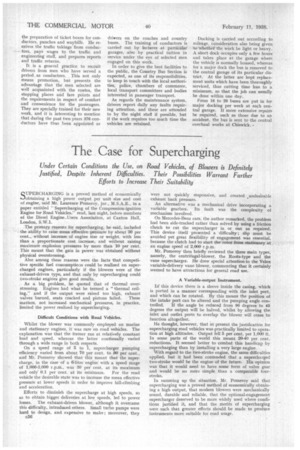The . Case for Supercharging
Page 106

If you've noticed an error in this article please click here to report it so we can fix it.
Under Certain Conditions the Use, on Road Vehicles, of Blowers is Definitely justified, Despite Inherent Difficulties. Their Possibilities Warrant Further Efforts to Increase Their Suitability
SUPERCHARGING is a proved method of economically obtaining a high power output per unit size and cost of engine, said Mr. Laurence Pomeroy, jnr., M.S.A.E., in a paper entitled "Supercharging of the Compression-ignition Engine for Road Vehicles." read, last night, before members of the Diesel Engine _Users Association, at Caxton Hall, London, S.W.1.
The primaly reasons for supercharging, he said, included the ability to raise mean effective pressure by about 30 per cent., without increase of engine size or weight, with less than a proportionate cost increase, and without raising maximum explosion pressures by more than 10 per cent. This meant that the gain in power was obtained without physical overstressing. Also among these reasons were the facts that competitive specific fuel consumptions could be realized on supercharged engines, particularly if the blowers were of the exhaust-driven type, and that only by supercharging could two-stroke engines give good results.
As a big problem, he quoted that of thermal overstressing. Engines had what he termed a "thermal ceiling," and if the output were raised too high, exhaust valves burned, seats cracked and pistons failed. These matters, not increased mechanical pressures, in practice, limited the power realized by supercharging.
Difficult Conditions with Road Vehicles.
Whilst the blower was commonly employed on marine and stationary engines, it was rare on road vehicles. The explanation was that the former ran at relatively constant load and speed, whereas the latter continually varied through a wide range in both respects.
On a speed range of 5 to 1, supercharger pumping efficiency varied from about 70 per cent. to SO per cent., and Mr. Pomeroy showed that this meant that the supercharge, in the case of a 6-litre engine with a speed range of 1,000-3,000 r.p.m., was 30 per cent. at its maximum and only 0.1 per cent. at its minimum. For the road vehicle the desirable state was to increase the mean effective pressure at lower speeds in order to improve hill-climbing and acceleration.
Efforts to diminish the supercharge at high speeds, so as to obtain bigger deliveries at low speeds, led to power losses. The exhaust-driven blower, although it overcame this difficulty, introduced others. Small turbo pumps were bard to design, and expensive to make; moreover, they
c5fl were not quickly responsive, and created .undesirable exhaust back pressure.
An alternative was a mechanical drive incorporating a variable gearbox. Its fault was the complexity of mechanism involved.
On Mercedes-Benz cars, the author remarked, the problem had been side-tracked rather than solved by using a friction clutch to cut the supercharger in or out as required. This device itself presented a difficulty ; slip must be avoided yet great flexibility of engagement was essential, because the clutch had to start the'retet &inn-stationary at an engine speed of 2,000 rp.m.
Mr. Pomeroy then briefly reviewed the three main types, namely, the centrifugal-blower, the Roots-type and the vane supercharger. He drew special attention to the Velox variable-delivery vane blower, commenting that it certainly seemed to have attractions for general road use.
A Variable-output Instrument.
Id this device there is a sleeve inside the casing, which is ported in a manner corresponding with the inlet port, and which can be rotated. By this means the position of the intake port can be altered and the pumping angle con
trolled. If the angle be reduced from 90 degrees to 45 degrees the output will be halved, whilst by allowing the inlet and outlet ports to overlap the blower will cease to function altogether.
He thought, however, that at present the justification for supercharging road vehicles was practically limited to operation at high altitudes. Output fell 5 per cent. per 1,000 ft. In some parts of the world this meant 20-40 per cent. reductions. It seemed better to combat this handicap by supercharging than by installing a very large engine.
With regard to the thvo-stroke engine, the same difficulties applied, but it had been contended that a supercharged two-stroke would be the engine of the future. His opinion was that it would need to have some form of valve gear and would be no more simple than a comparable fourstroke.
In summing up the situation, Mr. Pomeroy said that supercharging was a proved method of economically obtaining a high output, that modern blowers were mechanically sound, durable and reliable, that the optional-engagement supercharger deserved to be more widely used where conditions justified it, and that the merits of supercharging were such that greater efforts should be made to produce instruments more suitable for road usage.




























































































































































